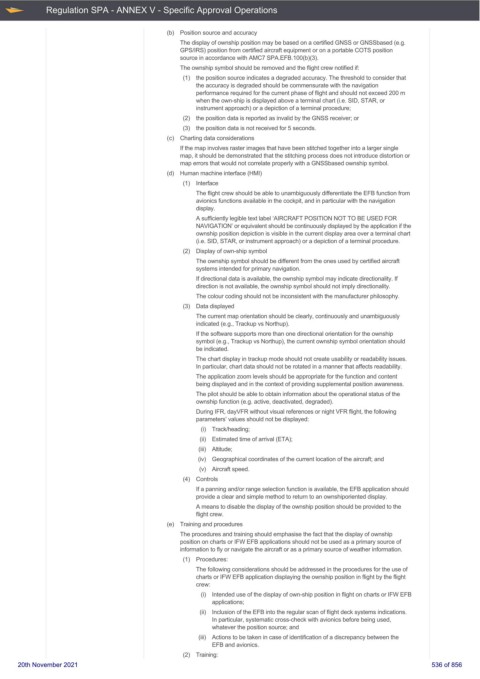Page 536 - UK Air Operations Regulations (Consolidated) 201121
P. 536
~
~ Regulation SPA - ANNEX V - Specific Approval Operations Centrik
(b) Position source and accuracy
The display of ownship position may be based on a certified GNSS or GNSSbased (e.g.
GPS/IRS) position from certified aircraft equipment or on a portable COTS position
source in accordance with AMC7 SPA.EFB.100(b)(3).
The ownship symbol should be removed and the flight crew notified if:
(1) the position source indicates a degraded accuracy. The threshold to consider that
the accuracy is degraded should be commensurate with the navigation
performance required for the current phase of flight and should not exceed 200 m
when the own-ship is displayed above a terminal chart (i.e. SID, STAR, or
instrument approach) or a depiction of a terminal procedure;
(2) the position data is reported as invalid by the GNSS receiver; or
(3) the position data is not received for 5 seconds.
(c) Charting data considerations
If the map involves raster images that have been stitched together into a larger single
map, it should be demonstrated that the stitching process does not introduce distortion or
map errors that would not correlate properly with a GNSSbased ownship symbol.
(d) Human machine interface (HMI)
(1) Interface
The flight crew should be able to unambiguously differentiate the EFB function from
avionics functions available in the cockpit, and in particular with the navigation
display.
A sufficiently legible text label ‘AIRCRAFT POSITION NOT TO BE USED FOR
NAVIGATION’ or equivalent should be continuously displayed by the application if the
ownship position depiction is visible in the current display area over a terminal chart
(i.e. SID, STAR, or instrument approach) or a depiction of a terminal procedure.
(2) Display of own-ship symbol
The ownship symbol should be different from the ones used by certified aircraft
systems intended for primary navigation.
If directional data is available, the ownship symbol may indicate directionality. If
direction is not available, the ownship symbol should not imply directionality.
The colour coding should not be inconsistent with the manufacturer philosophy.
(3) Data displayed
The current map orientation should be clearly, continuously and unambiguously
indicated (e.g., Trackup vs Northup).
If the software supports more than one directional orientation for the ownship
symbol (e.g., Trackup vs Northup), the current ownship symbol orientation should
be indicated.
The chart display in trackup mode should not create usability or readability issues.
In particular, chart data should not be rotated in a manner that affects readability.
The application zoom levels should be appropriate for the function and content
being displayed and in the context of providing supplemental position awareness.
The pilot should be able to obtain information about the operational status of the
ownship function (e.g. active, deactivated, degraded).
During IFR, dayVFR without visual references or night VFR flight, the following
parameters’ values should not be displayed:
(i) Track/heading;
(ii) Estimated time of arrival (ETA);
(iii) Altitude;
(iv) Geographical coordinates of the current location of the aircraft; and
(v) Aircraft speed.
(4) Controls
If a panning and/or range selection function is available, the EFB application should
provide a clear and simple method to return to an ownshiporiented display.
A means to disable the display of the ownship position should be provided to the
flight crew.
(e) Training and procedures
The procedures and training should emphasise the fact that the display of ownship
position on charts or IFW EFB applications should not be used as a primary source of
information to fly or navigate the aircraft or as a primary source of weather information.
(1) Procedures:
The following considerations should be addressed in the procedures for the use of
charts or IFW EFB application displaying the ownship position in flight by the flight
crew:
(i) Intended use of the display of own-ship position in flight on charts or IFW EFB
applications;
(ii) Inclusion of the EFB into the regular scan of flight deck systems indications.
In particular, systematic cross-check with avionics before being used,
whatever the position source; and
(iii) Actions to be taken in case of identification of a discrepancy between the
EFB and avionics.
(2) Training:
20th November 2021 536 of 856

